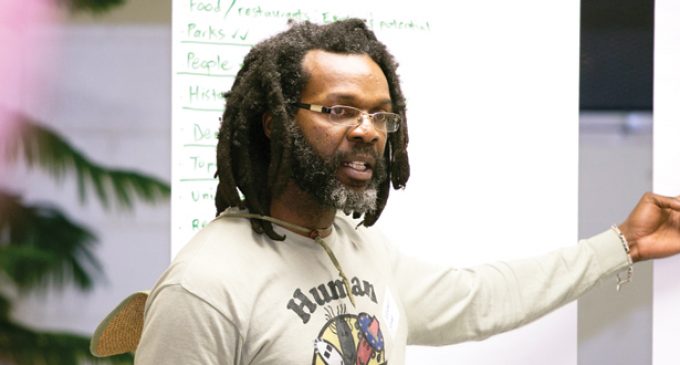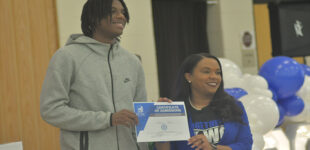Winston-Salem planners ask East-Northeast planning area residents to help with growth

(Above: Photos by Erin Mizelle for The Chronicle- Michael Banner reveals his group’s list of concerns at the East-Northeast Area Plan Update kickoff meeting on Tuesday, March 17 at the Rupert Bell Neighborhood Center.)
By Tori Pittman For The Chronicle
“Come share your ideas about how your community should grow.”
That’s what the advertisement said to attract people to the meeting last month with city-county planners who would discuss the East-Northeast Winston-Salem Planning Area at the Rupert Bell Neighborhood Center.
Twenty to 30 residents came to the meeting.
“The people are our main source,” said Marco Andrade, project planner. “They see what’s going on in the community every day. So we want them to tell us their ideas, suggestions, and concerns.”
Material from the city says the City-County Planning Board of Forsyth County and Winston-Salem is responsible for preparing and maintaining a comprehensive plan for Forsyth County.
“Comprehensive plans” address land use, usually based on zoning. City-County planners discover what residents want in their communities, then present those desires to City Council, which will make laws governing the kind of businesses and other development that will be approved for the communities, if developers want to be in the areas.
At the meeting last month, maps were displayed to show what work has been done in the East-Northeast area, as well as sketches and plans on future developments. The district includes parts of the East Ward and Northeast Ward. The planning district has mostly black residents.
At the meeting, Chris Murphy, one of the department’s leaders, said the City-County Planning Board’s Legacy 2030 Comprehensive plan involves expansion and improvements on all of Winston-Salem, including the East-Northeast area. The goal is to have new developments that will attract people to reside, increasing the population by 120,000. This comprehensive plan has been accredited twice by the American Planning Association.
Kirk Ericson followed up, explaining how the current plan was adopted by City Council and the City-County Planning Board in 2008. The March 17 presentation was to show the existing conditions from that adopted plan, while having the intention to reach out to the community to express their views and to give the board more ideas.
“During the 2008 plan, people were involved and were giving suggestions,” said Derwin Montgomery, council member representing the East Ward. “It takes what the community wants to see, while the developers figure out how to make it happen.”
Montgomery was unable to attend the meeting because of prior engagements, but he spoke to The Chronicle later.
At the meeting, Byron Brown, another project planner, gave demographics of the East-Northeast Winston-Salem Planning Area, which is 80 percent African-American, followed by smaller percentages of Asian, Hispanic and Caucasian residents.
The area encompasses about 14,360 people and 4,523 acres. It is generally bounded on the north by North Liberty Street and Lansing Drive; on the east by Brushy Fork Branch, Winston Lake Park and U.S. 158; on the south by the Southern Railway; and on the west by U.S. 52.
Brown said the historical landmarks such as the bridges, archaeological sites and certain properties like the George Black House and Brickyard are to remain on site. The Historic Resources Commission staff has reviewed the sites since 2009, giving input into what should stay, since some have been moved or demolished.
Andrade presented improvements that have come along from the adoption plan in 2008. A CVS Pharmacy was built on Martin Luther King Jr. Drive along with the rehabilitation of the building for Transitional Housing for Homeless Veterans on Glenn Avenue. Developments have been made along the Smith-Reynolds airport. Also, new residential houses are to be built along Third, Fourth and Fifth Streets.
Then the planning department took the next hour for the residents to divide into two groups and conduct a list of what they like about the district, what they don’t like and suggestions for improvement. Altogether there were two pages of what they liked about the residential area, while a total of three to four pages about what they didn’t like about the area.
Certain residents had a common interest about the parks in the area as well as Winston Lake. One resident in particular, Michael Banner, father of two, was mostly fascinated with the historical aspect of the community.
“You can walk past a street and not know the history behind it,” Banner said. “You wouldn’t know if that was where the original fire station was located or if that place was where the Black Panthers would have their meetings. You wouldn’t know unless you ask.”
Most of the residents’ main concerns were the crime rates, the neglectful landlords and housing, and how certain necessities need to be in a closer range instead of them having to drive miles across town. They want more sit-in restaurants in their area instead of fast food places.
Bobbie Collins, one of the elders who has resided in the East-Northeast area the longest, spoke about how thankful she was to have stayed in the same house that she grew up in and have the same phone number. Her concern was how some of the areas look “run-down.”
“We need to have some beautification in this area,” Collins said.
More concerns from the community were that sidewalks and side streets need to be paved for the safety of elders and children.
There was also talk of the lack of job opportunities and economic development within the area. According to Montgomery, the East area has had some economic development. He stated, however that the lack of development is because of the private sectors not investing enough into the community.
“Bonds have passed into the area. Investments were past due to be seen. The same strategies that enhanced downtown Winston needs to be the same thing for the East area,” he said.
Montgomery said it depends on the private sector making the time and investments and residents should see the adopted plan go into full swing in the next five years. He said that the Council and city are pushing this plan to make it happen based on what the community is saying what they want.
“I would like to see the elders and the youth come together,” said Martha Reid, president of the East-Northeast Neighborhood Association.
Reid states that from her travelling abroad, she would like certain things she’s seen infused within the community.
Another suggestion made from the residents was to make something other than the recreational center a gathering place for the youth. The millennial generation should be involved in such meetings to voice their opinions.
The planning department will take the residents’ suggestions and come up with a draft plan that will closely fit their needs. Several more meetings are scheduled before the new plan is presented to the City Council for approval later this year.
Chronicle Managing Editor Donna Rogers contributed to this report.















